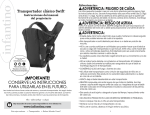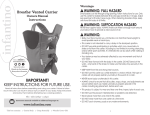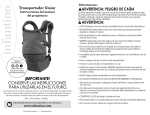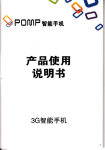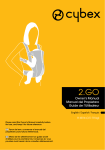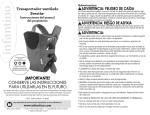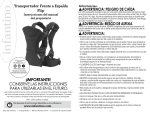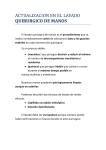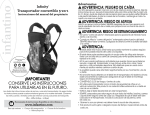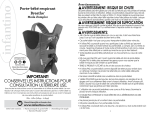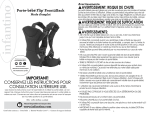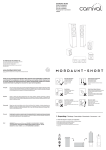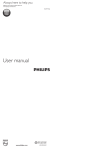Download important! keep instructions for future use.
Transcript
TM Owners Manual Instructions English Swift Carrier Visit us online to view our instructional videos and learn more about our products at www.infantino.com IMPORTANT! KEEP INSTRUCTIONS FOR FUTURE USE. Read all instructions before assembling and using your carrier. Failure to follow each instruction can result in serious injury or death to your baby. Keep instructions and review them before attempting new carrying positions. 8lbs - 25lbs (3.6kgs - 11.3kgs) This box contains: 1 - Carrier 1 - Wonder Cover ™ 2-in-1 Bib Warnings: WARNING: FALL HAZARD Small babies can fall through a leg opening. Follow instructions for use. Only use this carrier for babies between 8 lbs (3.6 kgs) and 25 lbs (11.3 kgs). Adjust leg openings to fit baby’s legs snugly. When fastening shoulder straps, keep one hand on baby at all times. WARNING: SUFFOCATION HAZARD NEVER lean against baby. ALWAYS make sure there is enough room around your baby’s face to provide a clear source of air. WARNING: • The baby must face toward you until he/she can hold the head upright to avoid possible neck or back injury. • This carrier is not intended to carry a baby in the backpack position. • DO NOT use while participating in activities which can cause the baby to shake or fall from the carrier, including but not limited to running, exercising, and/or other sports activities. It is intended for use by adults while walking or standing only. • Your balance may be adversely affected by your movement and that of your baby. • DO NOT lean forward with the baby in the carrier. DO NOT bend at the waist – only bend at the knees to make sure the baby stays securely in the carrier. • KEEP AWAY from fire and strong heat sources. • DO NOT use this carrier as a child restraint in a motor vehicle. This type of carrier will not properly restrain your baby in the event of a crash. • NEVER leave a baby unattended in this carrier. • ALWAYS check to ensure that all buckles, snaps, straps, and adjustments are secure before each use. Make sure the baby is properly placed in the carrier, including leg placement, before each use. • This product is subject to wear and tear over time. Inspect prior to each use. • DO NOT use this product if deterioration or problems are detected. • Never place more than one child in this carrier. • DO NOT wear more than one carrier at a time ever. • DO NOT use in showers, pools or any water environments. 1. Helpful Hints: English * The Swift Carrier is designed simply to be comfortable and convenient for both you and your baby, and to provide more physical contact between the two of you. TM * Before placing the baby in the carrier, correctly fit the straps to your body. * How do you know if your baby is riding at the right height? - You should be able to tilt your head forward and kiss the top of your baby’s head. * Facing-in position - Baby facing toward you - Until your baby is able to hold his/her head upright, this is the ideal position. Since there is no material between you and your infant, it affords him or her lots of close physical contact and attention, while leaving your hands free. In this position, you can entertain and bond with your baby by talking, touching, playing or just making eye-contact. * When placing your baby in or taking them out of the carrier, sitting down will make the procedure easier. Until you are familiar with the placement of baby, it is also recommended to do so over a soft surface. * It is best to limit the use of your carrier to 10-20 minutes until you and your baby are both completely comfortable in it together. * For babies between 8-11 lbs. (3.6-5.0 kgs.), the leg loops must be adjusted to make the leg hole smaller and to avoid a potential falling hazard. * Facing-out position - Baby facing away from you - Once your baby is able to hold his/her head up, your child is ready for a new adventure. In this position, he or she can visually explore their surroundings while maintaining a secure, close contact with you. * Wearing the carrier closer to your body and higher up on your chest will minimize the stress to your back and shoulders from prolonged use. Care Instructions Machine wash cold, separately, on gentle cycle with mild detergent. DO NOT bleach. DO NOT use fabric softeners. Wipe clean with a cloth or sponge between machine washings. Drip dry only. DO NOT iron. 2. Carrier Body Front: Transportador de Frente: 3. 4. English Carrier Body Back: Consejo de Transportador Trasero: Instructions: 1 Carrier use for an infant: Facing-in position * Until your baby is able to hold his/her head upright, this is the ideal position. Since there is no material between you and your infant, if affords him or her lots of close physical contact and attention, while leaving your hands free. In this position, you can entertain and bond with your baby by talking, touching, playing or just making eye-contact. 1. Put on the carrier (like a vest) by placing each of your arms through the “shoulder straps”. Please not that the carrier body is permanently connected to your left strap, and the Infantino “i” logo is visible on the right strap. The “shoulder strap buckles” and the “buckle pocket” on the carrier body should both be facing down. 2. The round “back strap adjuster” should fit comfortably in the middle of your back between your shoulder blades. If necessary, you can pull the adjuster down by using the “back strap adjustment loop”. 3. Connect the two “shoulder strap buckles” located on each “shoulder strap” to their mates located in the “buckle pocket” of the carrier body. This step creates the bottom support for the child and a leg opening on the closed side of the carrier. 4. With the carrier open on one side and the baby facing you, carefully slide the baby into the carrier by fitting his/her leg through the opening on the closed side of the carrier. * IMPORTANT! Keep one hand on the baby until all buckles and straps are properly fastened. * Make sure your baby’s leg goes through the opening on the closed side of the carrier. 5. While supporting the baby with one hand, wrap the carrier around the baby so that the child’s free leg is below the “side closure buckle” and his/her arm is above it. Secure the side by first pressing the hook & loop on the carrier body to its mate on the flap connected to the shoulder strap (under the “side closure buckle”) then by fastening the “side closure buckle”. You will hear a ‘click’ when the buckle is locked in position. 6. Support the baby’s head by attaching the two “head support buckles” above each arm. You will hear a ‘click’ when the buckle is locked in position. Customize the firmness of the head support by adjusting both of the “head support tighteners”. * IMPORTANT! Always make sure there is enough room around your baby’s face to provide a clear source of air. 7. Attach the “leg loops” to the “leg loop buttons” on BOTH SIDES of the carrier. (For babies over 11 lbs. or 5 kgs., this step is unnecessary.) * IMPORTANT! For babies between 8-11 lbs., the leg loops must be attached to make the leg hole smaller and to avoid a potential falling hazard. 8. To adjust how high the baby rides on your chest, lift the baby slightly and pull the “shoulder strap end” forward, first on one strap, then on the other. When the baby is properly positioned, you should be able to tilt your head forward and kiss the top of your baby’s head. 6. English 5. Using your 2-in-1 bib: Facing-in position 1. Place the bib between your chest and the baby’s head. The bib is reversible, so either side can be facing out. 2. Attach the “2-in-1” bib by squeezing the two “hook & loop circles” on either side of the bib against the two “bib attachment strips” located on the underneath side of the “shoulder straps”. * IMPORTANT! Always make sure there is enough room around your baby’s face to provide a clear source of air. 2 Carrier use for an older baby: Facing-out position * WARNING! The baby must face toward you until he/she can hold the head upright to avoid possible neck or back injury. * Once your baby is able to hold his/her head up, your child is ready for a new adventure. In this position he or she can visually explore their surroundings while maintaining a secure, close contact with you. * When the baby is carried in the facing-out position, the attachment of the leg loops is UNNECESSARY, regardless of the weight of the child. 1. Repeat steps 1-4 of 1 CARRIER USE FOR AN INFANT: Facing-in position 2. Ensure that BOTH “head support buckles” are unfastened, then fold down the “head support area.” 3. With the carrier open on one side and the baby facing away from you, carefully slide the baby into the carrier by fitting his/her leg through the opening on the closed side of the carrier. * IMPORTANT! Keep one hand on the baby until all buckles and straps are properly fastened. * Make sure your baby’s leg goes through the opening on the closed side of the carrier. 7. While supporting the baby with one hand, wrap the carrier around the baby so that the child’s free leg is below the “side closure buckle” and his/her arm is above it. Secure the side by first pressing the hook & loop on the carrier body to its mate on the flap connected to the shoulder strap (under the “side closure buckle”) then by fastening the “side closure buckle”. You will hear a ‘click’ when the buckle is locked in position. 5. Attach both “head support buckles,” making sure that the “head support area” remains in the folded-down position. You will hear a ‘click’ when each buckle is locked in position. To ensure that the head support stays folded down, check that the webbing of the head support strap does not have a twist in it. If it does, unfasten the buckle, remove the twist from the strap, and refasten the buckle. Check the strap on the other side of the carrier as well. 6. To adjust how high the baby rides on your chest, lift the baby slightly and pull the “shoulder strap end” forward, first on one strap, then on the other. When the baby is properly positioned, you should be able to tilt your head forward and kiss the top of your baby’s head. * The baby should NEVER be leaning forward in the carrier. * PLEASE NOTE: The arms of smaller babies should be positioned below the “head support buckles.” Larger babies’ arms should be above the buckles, and rest comfortably over the folded down head support. 8. English 4. Using your 2-in-1 bib: Facing-out position 1. (Either side of the bib can be facing out.) Attach the “2-in-1 bib” by squeezing the two “hook & loop circles” on either side of the bib against the two “bib attachment strips” located inside the carrier body on either side, near the baby’s chest. 2. The bib should then be folded over the already folded down head support. Removing the baby from the carrier: in/out position * IMPORTANT! Keep at least one hand on the baby until he/she is safely removed from the carrier. 1. If fastened, release both “leg loops”. 2. Keeping one hand securely on your baby, release the two “head support buckles” first on the closed side of the carrier, then on the entry/exit side. 3. Still keeping one hand on your baby, release the “side closure buckle.” Holding the baby with both hands, lift him/her out the open side of the carrier. Place the child in a safe location before removing the carrier from your body. 9. Manual del propietario de Swift TM Texto De Las Instrucciones ¡IMPORTANTE! CONSERVE LAS INSTRUCCIONES PARA UTILIZARLAS MÁS ADELANTE. Lea todas las instrucciones antes de armar y usar este transportador. No seguir todas estas instrucciones puede dar como resultado lesiones graves o la muerte de su bebé. 8lbs - 25lbs (3.6kgs - 11.3kgs) Esta caja contiene: 1 transportador 1 babero Wonder Cover ™ 2 en 1 11. Advertencia: ADVERTENCIA: RIESGO DE CAIDA Los niños pequeños pueden caer por una de las aberturas para las piernas. Siga las instrucciones de uso. Sólo use este transportador para bebés de entre 8 lb (3.6 kg) y 25 lb (11.3 kg). Ajuste las aberturas para las piernas de modo que se adapten bien a las piernas de su bebé. Al atar las correas para los hombros, mantenga una mano en el bebé en todo momento. ADVERTENCIA: RIESGO DE ASFIXIA NUNCA se apoye contra el bebé. SIEMPRE asegúrese de que haya suficiente espacio alrededor del rostro de su bebé para proporcionar una fuente de aire libre. ADVERTENCIA: • Su equilibrio se puede ver afectado negativamente por su movimiento y el de su hijo. • NO se incline hacia delante con el bebé en el transportador. NO se doble por la cintura; sólo doble las rodillas para asegurarse de que el bebé se mantenga fijo en el transportador. • CONSÉRVELO ALEJADO del fuego y fuentes de calor fuerte. • NO use este transportador como fijación para el niño en un vehículo de motor. Este tipo de transportador no fijará debidamente a su hijo en caso de un choque. • NUNCA deje a un bebé desatendido en el transportador. • SIEMPRE revise para asegurarse de que todas las hebillas, broches, correas y ajustes estén bien cerrados antes de cada uso. Asegúrese de que su bebé esté debidamente colocado en el transportador, incluida la colocación de las piernas, antes de cada uso. • Este producto está sujeto a un desgaste normal al paso del tiempo. Inspecciónelo antes de cada uso. • NO use el producto si se detectan deterioros o problemas. 12. Español • El niño debe mirar hacia usted hasta que pueda mantener erguida la cabeza, para evitar posibles lesiones en el cuello o la espalda. • Este transportador no está hecho para llevar a un bebé en posición de mochila. • NO lo use al participar en actividades que puedan hacer que el bebé se sacuda o caiga del transportador, entre otras correr, hacer ejercicio y otras actividades deportivas. Está hecho para ser usado por adultos únicamente caminando o de pie. Advertencia: • NO coloque más de un niño en el transportador. • Nunca use más de un transportador a une tiempo. • NO lo use en las duchas, piscinas o cualquier ambientes de agua. Consejos Útiles: * El Transportador Swift está diseñado simplemente para ser cómodo y conveniente tanto para usted como para su hijo, y para proporcionar más contacto físico entre usted y su bebé. * Con este transportador, es más sencillo y seguro ajustar correctamente las correas en su cuerpo antes de colocar al bebé en él. * Con este transportador, es más sencillo y seguro ajustar correctamente las correas en su cuerpo antes de colocar al bebé en él. * Posición frontal - Niño mirando hacia usted - Hasta que el niño pueda sostener erguida la cabeza, ésta es la posición ideal. Dado que no hay materiales entre usted y su bebé, le da a éste mucho contacto físico cercano y atención, al tiempo que le deja libres las manos a usted. En esta posición, puede divertir a su bebé y establecer lazos con él hablando, tocándose, jugando o simplemente mirándose a los ojos. * Al cargar o descargar a su bebé en el transportador, sentarse hará más seguro el procedimiento. Hasta que esté familiarizado con los procedimientos de carga y descarga, también es más seguro hacerlo en una superficie suave. * Es mejor limitar el uso de su transportador a 10 ó 20 minutos hasta que usted y su bebé estén totalmente cómodos juntos en él. * En el caso de bebés entre 8 y 11 lb (3.6-5.0 kg), los lazos de las piernas deben ajustarse para hacer más pequeño el agujero para la pierna a fin de evitar un posible riesgo de caída. * Posición frontal - Niño mirando hacia fuera - Una vez que el niño pueda sostener erguida la cabeza, está listo para una nueva aventura. En esta posición, puede explorar visualmente su entorno al tiempo que mantiene un estrecho contacto con usted. * Llevar el transportador más cerca de su cuerpo y más alto en el pecho reducirá al mínimo la tensión en su espalda y hombros por el uso prolongado. Instrucciones de Lavado Lave a máquina, por separado, en ciclo suave y con un detergente suave. NO use blanqueador. NO use suavizantes de telas. Límpielo con un paño o esponja entre los lavados a máquina. Seque sólo dejándolo escurrir. NO lo planche. 13. Instrucciones: 1 Para Colocar al Bebé en el Transportador: Posición de Mirando Hacia Dentro * Hasta que el niño pueda sostener erguida la cabeza, ésta es la posición ideal. El soporte envolvente para la cabeza acuna la cabeza y cuello del bebé e incluso proporciona soporte cuando el bebé se duerme. Dado que no hay materiales entre usted y su bebé, le da a éste mucho contacto físico cercano y atención, al tiempo que le deja libres las manos a usted. En esta posición, puede divertir a su bebé y establecer lazos con él hablando, tocándose, jugando o simplemente mirándose alos ojos. Póngase el transportador (como un chaleco) colocando cada brazo a través de las “correas para los hombros”. Asegúrese de que el cuerpo del transportador esté conectado a la correa izquierda y que el logotipo de la “i” de Infantino sea visible en la correa derecha. Las “hebillas de las correas para los hombros” y el “bolsillo de la hebilla” del cuerpo del transportador deben estar ambos mirando hacia abajo. 2. El “ajustador de la correa de la espalda” redondo debe ajustarse cómodamente a la mitad de su espalda, abajo, entre los omóplatos. De ser necesario, puede tirar del ajustador hacia abajo con el “lazo de ajuste de la correa de la espalda”. 3. Conecte las dos “hebillas de las correas para los hombros” situadas en cada “correa para los hombros” con sus contrapartes en el “bolsillo de la hebilla” del cuerpo del transportador. Este paso crea el soporte inferior del niño y una abertura para la pierna en el lado cerrado del transportador. 4. Con el transportador abierto de un lado y el bebé mirando hacia usted, deslice cuidadosamente al bebé en el transportador haciendo pasar su pierna por la abertura del lado cerrado del transportador. * ¡IMPORTANTE! Mantenga una mano en el bebé hasta que todas las hebillas y correas estén debidamente cerradas. * Cerciórese de que la pierna de su bebé pase por la abertura del lado cerrado del transportador. 14. Español 1. 5. Sosteniendo al bebé firmemente con una mano, envuelva el transportador alrededor del bebé de modo que la pierna libre del bebé esté debajo de la “hebilla de cierre lateral” y su brazo esté sobre ella. Fije al bebé presionando primero el gancho y lazo del cuerpo del transportador contra su pareja en la solapa conectada a la correa para los hombros (bajo la “hebilla de cierre lateral”) y después cerrando la “hebilla de cierre lateral”. Escuchará un ‘clic’ cuando la hebilla esté en posición cerrada. 6. Sostenga la cabeza del bebé cerrando las dos “hebillas del soporte de la cabeza” sobre cada brazo. Escuchará un ‘clic’ cuando la hebilla esté en posición cerrada. Adapte la firmeza del soporte de la cabeza ajustando ambos “tensores del soporte de la cabeza”. * ¡IMPORTANTE! Siempre asegúrese de que haya suficiente espacio alrededor del rostro de su bebé para proporcionarle una fuente de aire libre. 7. Fije los “lazos de las piernas” a los “botones del lazo de la pierna” a AMBOS LADOS del transportador. (Para bebés de más de 11 lb o 5 kg, este paso no es necesario.) * ¡IMPORTANTE! En el caso de bebés entre 8 y 11 lb (3.6-5.0 kg), los lazos de las piernas deben fijarse para hacer más pequeño el agujero para la pierna y evitar un posible riesgo de caída. 8. Para ajustar la altura a la que el bebé viaja sobre su pecho, levante al bebé ligeramente y tire del “extremo de la correa para los hombros” hacia delante, primero de una correa, luego de la otra. Cuando el bebé está debidamente posicionado, usted debe poder inclinar la cabeza hacia delante y besar la parte superior de la cabeza de su bebé. 15. Uso de su Babero 2 en 1: Posición de Mirando Hacia Dentro 1. Coloque el babero entre su pecho y la cabeza del bebé. El babero es reversible, de modo que cualquiera de sus lados puede estar mirando hacia fuera. 2. Fije el “babero 2 en 1” apretando los dos “círculos de gancho y lazo” a ambos lados del babero contra las dos “tiras de fijación del babero” situadas del lado inferior de las “correas para los hombros.” * ¡IMPORTANTE! Siempre asegúrese de que haya suficiente espacio alrededor del rostro de su bebé para proporcionarle una fuente de aire libre. * ! ADVERTENCIA El niño debe mirar hacia usted hasta que pueda mantener erguida la cabeza, para evitar posibles lesiones en el cuello o la espalda. * Una vez que el niño pueda sostener erguida la cabeza, está listo para una nueva aventura. En esta posición, el bebé puede explorar visualmente su entorno al tiempo que mantiene un estrecho y seguro contacto con usted. * Cuando se lleva al bebé en posición de mirar hacia fuera, es INNECESARIO cerrar los lazos de la pierna, sin importar el peso del niño. 1. Repita los pasos 1 al 4 de la Posición 1 PARA COLOCAR AL BEBÉ EN EL TRANSPORTADOR: Posición de mirando hacia dentro. 2. Asegúrese de que AMBAS “hebillas del soporte de la cabeza” estén liberadas; luego doble hacia abajo el “área de soporte de la cabeza”. 3. Con el transportador abierto de un lado y el bebé mirando hacia fuera respecto de usted, deslice cuidadosamente al bebé en el transportador haciendo pasar su pierna por la abertura del lado cerrado del transportador. * ¡IMPORTANTE! Mantenga una mano en el bebé hasta que todas las hebillas y correas estén debidamente cerradas. * Cerciórese de que la pierna de su bebé pase por la abertura del lado cerrado del transportador. 16. Español 2 Para Colocar al Bebé en el Transportador: Posición de Mirando Hacia Fuera 4. Sosteniendo al bebé firmemente con una mano, envuelva el transportador alrededor del bebé de modo que la pierna libre del bebé esté debajo de la “hebilla de cierre lateral” y su brazo esté sobre ella. Fije al bebé presionando primero el gancho y lazo del cuerpo del transportador contra su pareja en la solapa conectada a la correa para los hombros (bajo la “hebilla de cierre lateral”) y después cerrando la “hebilla de cierre lateral”. Escuchará un ‘clic’ cuando la hebilla esté en posición cerrada. 5. Cierre ambas “hebillas del soporte de la cabeza” asegurándose de que el “área de soporte de la cabeza” permanezca doblada. Escuchará un ‘clic’ cuando cada hebilla esté cerrada en su sitio. Para asegurarse de que el soporte de la cabeza permanezca doblado, compruebe que la banda trenzada de la correa de soporte de la cabeza no esté torcida. Si lo está, suelte la hebilla, gire la correa para que no esté torcida y vuelva a cerrar la hebilla. Compruebe también la correa del otro lado del transportador. 6. Para ajustar la altura a la que el bebé viaja sobre su pecho, levante al bebé ligeramente y tire del “extremo de la correa para los hombros” hacia delante, primero de una correa, luego de la otra. Cuando el bebé está debidamente posicionado, usted debe poder inclinar la cabeza hacia delante y besar la parte superior de la cabeza de su bebé. * El niño NUNCA debe estar inclinado hacia delante en el transportador. * TENGA PRESENTE: Los brazos de los bebés más pequeños deben posicionarse debajo de las “hebillas del soporte de la cabeza”. Los brazos de los bebés más grandes deben estar arriba de las hebillas, y descansar cómodamente sobre el soporte de la cabeza doblado hacia abajo. 17. Uso de su Babero 2 en 1: Posición de Mirando Hacia Fuera 1. (Cualquier lado del babero puede estar mirando hacia fuera.) Fije el “babero 2 en 1” apretando los dos “círculos de gancho y lazo” a ambos lados del babero contra las dos “tiras de fijación del babero” situadas del lado inferior de las “correas para los hombros.” 2. El babero debe entonces doblarse sobre el soporte de la cabeza que ya está doblado hacia abajo. Para Sacar al Bebé del Transportador: Mirando Hacia Dentro o Hacia Fuera * ¡IMPORTANTE! Mantenga al menos una mano en el bebé hasta que lo haya sacado con seguridad del transportador. 1. Si están cerrados, libere los dos “lazos de las piernas”. 2. Manteniendo una mano firmemente en su bebé, libere las dos “hebillas del soporte de la cabeza” primero del lado cerrado del transportador, luego del lado de entrada o salida. 3. Manteniendo aún una mano en su bebé, libere la “hebilla de cierre lateral”. Sosteniendo al bebé con ambas manos, deslícelo para sacarlo del lado abierto del transportador. Coloque al bebé en un lugar seguro antes de quitarse el transportador del cuerpo. 18. Designed with in California © 2010 Infantino, LLC 4920 Carroll Canyon Road, Suite 200 | San Diego, CA 92121 USA www.infantino.com A Step2 Family Company® Infantino, Ltd. Prospect House Business Center, High Wycombe HP13 6LA, UK Complies with safety requirements of ASTM F2236-09a. BEFORE USING THIS CARRIER: Review and save the Instruction Manual for future reference. Please call Infantino at 1-800-840-4916 (for US or Canada) or 00+1 858-457-9797 in Europe with any questions or visit our website www.infantino.com. ANTES DE USAR ESTE TRANSPORTADOR: Revise y guarde el Manual de Instrucciones para consultarlo posteriormente. Llame a Infantino al 1-800-840-4916 (para los EE.UU. o Canadá) o al 00+1 858-457-9797 en Europa para hacer cualquier pregunta, o visite nuestro sitio Web en www infantino.com.























